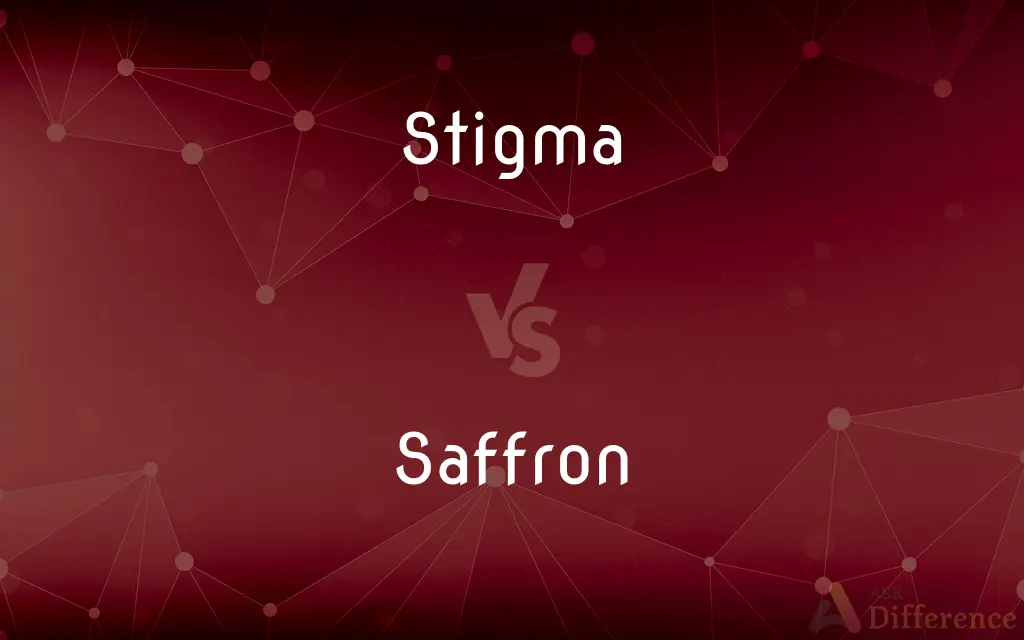Stigma vs. Saffron — What's the Difference?

Difference Between Stigma and Saffron
ADVERTISEMENT
Compare with Definitions
Stigma
An association of disgrace or public disapproval with something, such as an action or condition
"Depression ... has become easier to diagnose, and seeking treatment does not carry the stigma it once did" (Greg Critser).
Saffron
Saffron (pronounced or ) is a spice derived from the flower of Crocus sativus, commonly known as the "saffron crocus". The vivid crimson stigma and styles, called threads, are collected and dried for use mainly as a seasoning and colouring agent in food.
Stigma
A visible indicator of disease.
Saffron
A corm-producing plant (Crocus sativus) native to the eastern Mediterranean region, having purple or white flowers with orange stigmas.
Stigma
A small bodily mark, especially a birthmark or scar, that is congenital or indicative of a condition or disease.
ADVERTISEMENT
Saffron
The dried aromatic stigmas of this plant, used to color foods and as a cooking spice and dyestuff.
Stigma
(Psychology) A bleeding spot on the skin considered to be a manifestation of conversion disorder.
Saffron
A moderate or strong orange yellow to moderate orange.
Stigma
Stigmata(Christianity) Bodily marks, sores, or sensations of pain corresponding in location to the crucifixion wounds of Jesus, believed to be given as divine recognition of devotion.
Saffron
The plant Crocus sativus, a crocus.
Stigma
(Botany) The apex of the pistil of a flower, on which pollen grains are deposited and germinate.
Saffron
A spice (seasoning) and colouring agent made from the stigma and part of the style of the plant, sometimes or formerly also used as a dye and insect repellent.
Stigma
(Biology) A small mark, spot, or pore, such as the respiratory spiracle of an insect or an eyespot in certain protists.
Saffron
An orange-yellow colour, the colour of a lion's pelt.
Stigma
(Archaic) A mark burned into the skin as a visible identifier of a person as a criminal or slave; a brand.
Saffron
Having an orange-yellow colour.
Stigma
A mark of infamy or disgrace.
Saffron
To add saffron to (a food), for taste, colour etc.
Saffroned water, saffroned rice.
Stigma
A scar or birthmark.
Saffron
To give a saffron colour to (something).
Stigma
A mark on the body corresponding to one of the wounds of the Crucifixion on Jesus' body, and sometimes reported to bleed periodically.
Saffron
To dye (a fabric, garment, etc.) with a saffron-based dye.
Stigma
An outward sign; an indication.
Saffron
To colour (a metal or wooden surface) with a gilding product containing saffron.
Stigma
(botany) The sticky part of a flower that receives pollen during pollination.
Saffron
(figuratively) To embellish.
Stigma
(medicine) A visible sign or characteristic of a disease.
Saffron
A bulbous iridaceous plant (Crocus sativus) having blue flowers with large yellow stigmas. See Crocus.
Stigma
(typography) A ligature of the Greek letters sigma and tau, (Ϛ/ϛ).
Saffron
The aromatic, pungent, dried stigmas, usually with part of the stile, of the Crocus sativus. Saffron is used in cookery, and in coloring confectionery, liquors, varnishes, etc., and was formerly much used in medicine.
Stigma
A mark made with a burning iron; a brand.
Saffron
An orange or deep yellow color, like that of the stigmas of the Crocus sativus.
Stigma
Any mark of infamy or disgrace; sign of moral blemish; stain or reproach caused by dishonorable conduct; reproachful characterization.
The blackest stigma that can be fastened upon him.
All such slaughters were from thence called Bartelmies, simply in a perpetual stigma of that butchery.
Saffron
Having the color of the stigmas of saffron flowers; deep orange-yellow; as, a saffron face; a saffron streamer.
Stigma
That part of a pistil which has no epidermis, and is fitted to receive the pollen. It is usually the terminal portion, and is commonly somewhat glutinous or viscid. See Illust. of Stamen and of Flower.
Saffron
To give color and flavor to, as by means of saffron; to spice.
And in Latyn I speak a wordes few,To saffron with my predication.
Stigma
A small spot, mark, scar, or a minute hole; - applied especially to a spot on the outer surface of a Graafian follicle, and to spots of intercellular substance in scaly epithelium, or to minute holes in such spots.
Saffron
Old World crocus having purple or white flowers with aromatic pungent orange stigmas used in flavoring food
Stigma
A red speck upon the skin, produced either by the extravasation of blood, as in the bloody sweat characteristic of certain varieties of religious ecstasy, or by capillary congestion, as in the case of drunkards.
Saffron
Dried pungent stigmas of the Old World saffron crocus
Stigma
One of the external openings of the tracheæ of insects, myriapods, and other arthropods; a spiracle.
Saffron
A shade of yellow tinged with orange
Stigma
A point so connected by any law whatever with another point, called an index, that as the index moves in any manner in a plane the first point or stigma moves in a determinate way in the same plane.
Stigma
Marks believed to have been supernaturally impressed upon the bodies of certain persons in imitation of the wounds on the crucified body of Christ. See def. 5, above.
Stigma
The apical end of the style where deposited pollen enters the pistil
Stigma
A symbol of disgrace or infamy;
And the Lord set a mark upon Cain
Stigma
An external tracheal aperture in a terrestrial arthropod
Stigma
A skin lesion that is a diagnostic sign of some disease
Share Your Discovery

Previous Comparison
Revenge vs. Reciprocity
Next Comparison
Direct vs. Oversee













































